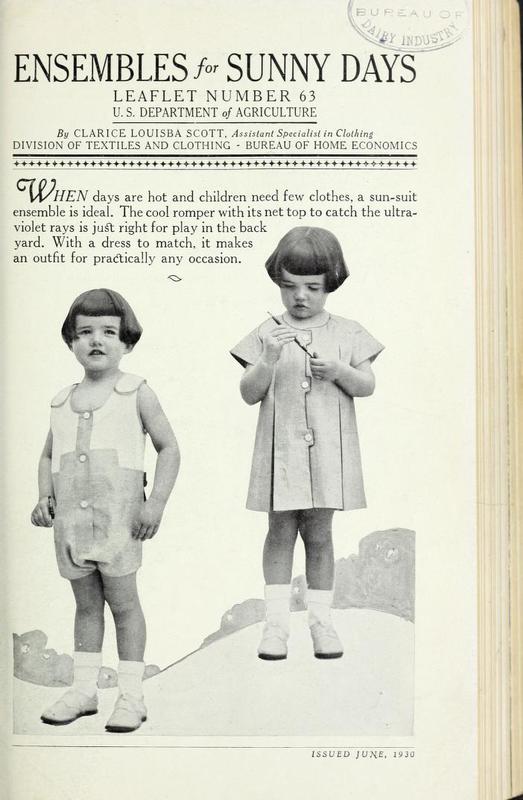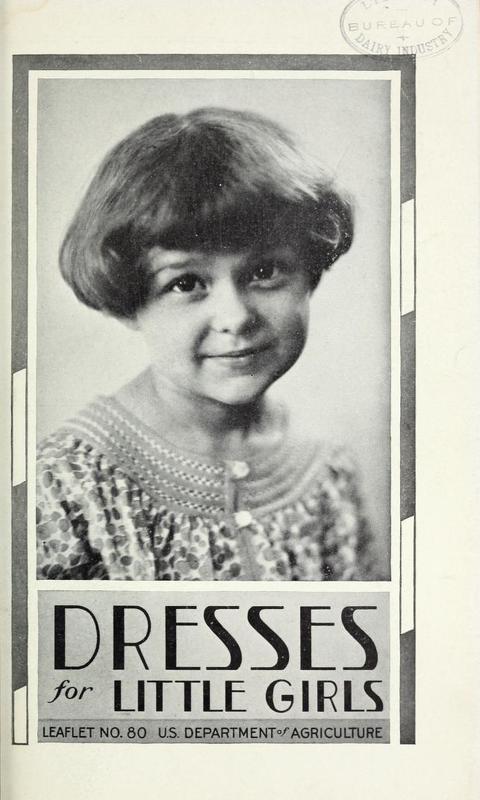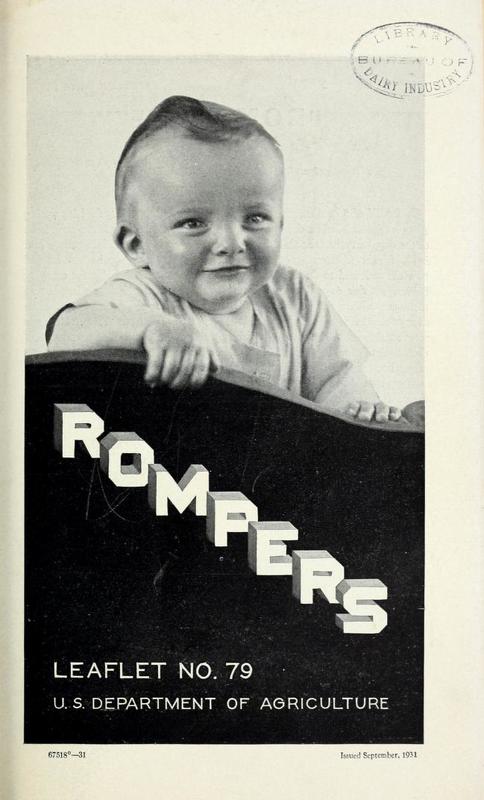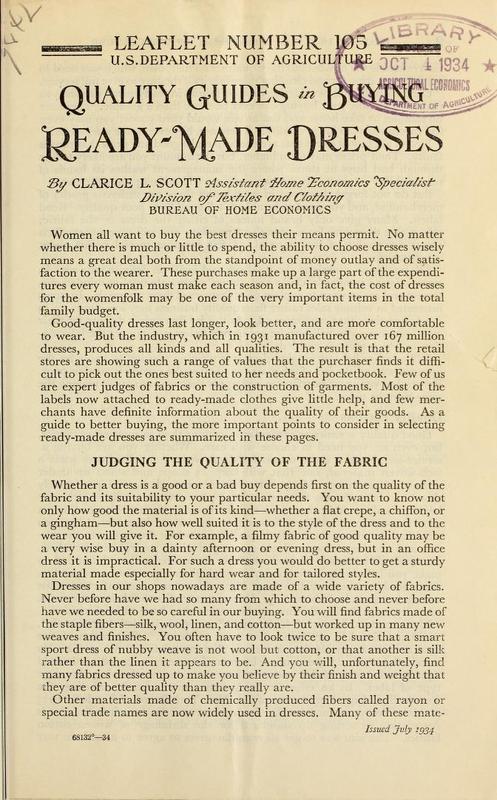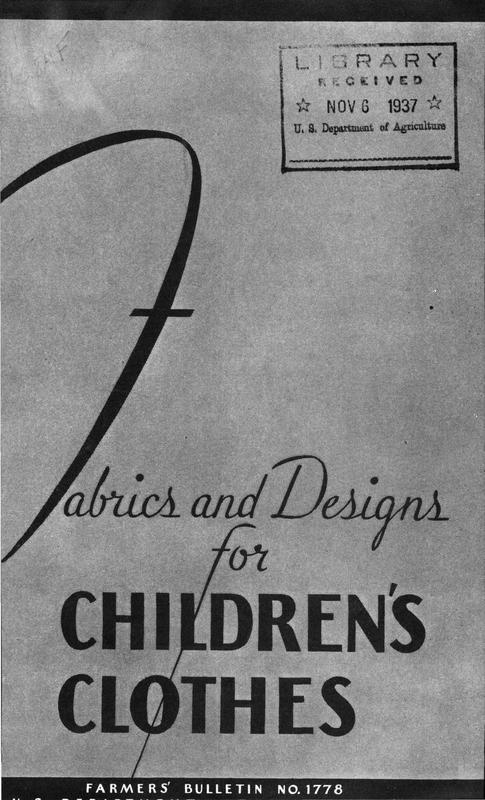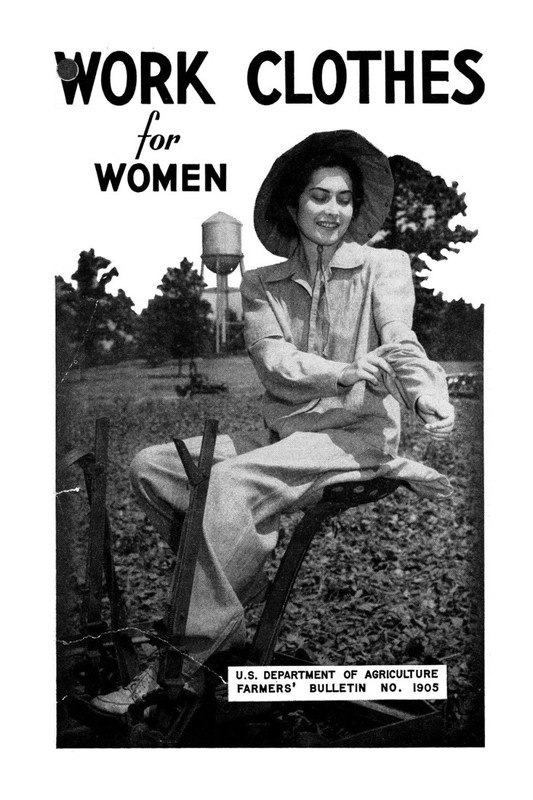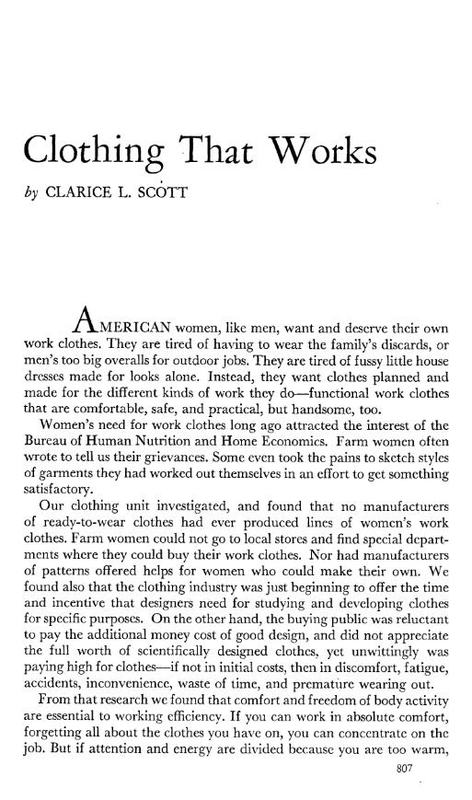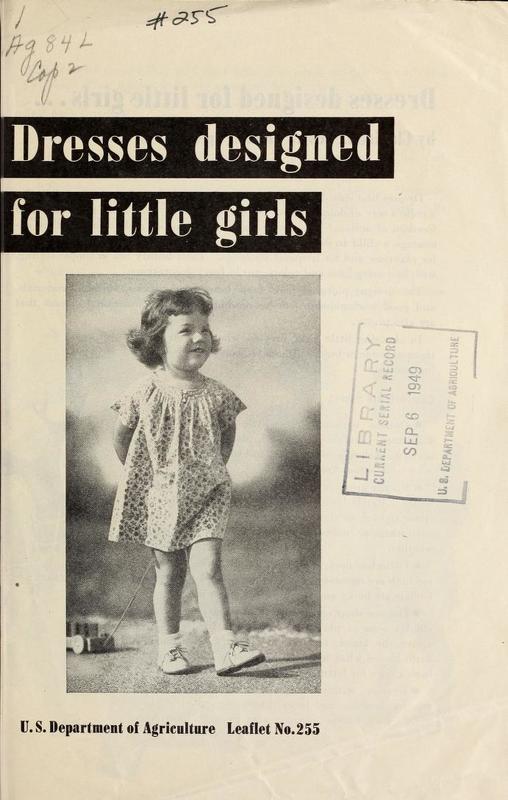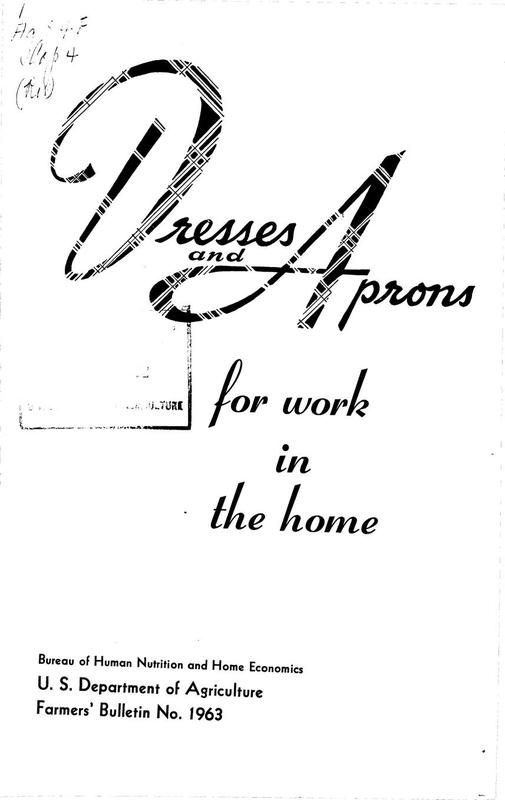The Division of Textiles and Clothing: Clarice Louisba Scott
Like most women, 'Scotty' loves good-looking clothes. All her styles have to measure up to eye appeal--becoming colors, attractive, stream-lined styles. 'Smart women do their best work if they are dressed sensibly and suitably for their jobs,' she says. She believes that women can do some kinds of men's work in becoming feminine garments.
Prescott Evening Courier, February 16, 1950, section 1, p. 2.
Clarice Louisba Scott was an employee of the Division of Textiles and Clothing who authored many publications. Here is a sample:
Ensembles for Sunny Days (1930)
Scott, Claice Louisba
U.S. Department of Agriculture. Leaflet Number 63
"When days are hot and children need few clothes, a sun-suit ensemble is ideal. The cool romper with its net top to catch the ultra-violet rays is just right for play in the backyard. With a dress to match, it makes an outfit for practically any occasion.
Over a sun suit a child need merely put on a matching dress or overblouse to be appropriately clad for the street, and quite as quickly it can be shed for a dig in the sand pile. Again, when it is time to go indoors, the dress or blouse looks better at the dinner table, and there is less danger of cooling off too quickly after the heat of the sun.
The little girl on page 1 wears a sun-suit romper with a front opening so convenient that she can dress herself. When she grows taller, the tabs on the shoulders can be slipped back and tacked into place again. Her matching tailored dress with its front closing can be put on and fa^ened in a jiffy.
The 3-year-old lad shown below buttons his self-help trousers on to a straight net top. He can put on the matching overblouse all by himself, for the buttons are just the right size and in the most convenient place for his tiny inexperienced fingers to manage easily. All the little things that often make clothes a nuisance to the boy are done away with in this design."
Dresses for Little Girls (1931)
Scott, Clarice Louisba
U.S. Department of Agriculture. Leaflet Number 80
"Dresses for the little girl of to-day are designed to meet her own particular needs. They are comfortable, convenient, simple, and sturdy, not only because these qualities are practical, but also because they are appropriate and in good taste. Her styles, unlike those for grown-ups, change little from season to season, but they are fashionable and individual, nevertheless. Simple foundation dresses that hang straight from the shoulders, un-belted and loose, are always becoming, and they may be varied in innumerable ways by details of design, colors, and materials."
Rompers (1931)
Scott, Clarice Louisba
U.S. Department of Agriculture. Leaflet Number 79
"A baby of 5 or 6 months needs clothes designed especially for his growing activities. Infant dresses are appropriate when sleeping is the main issue of the day, but when the child begins to creep they hamper and discourage him in all his efforts. Even the outfits designed for older children, who have learned to walk well and to do things for themselves, are uncomfortable for creeping babies. At this stage they need garments that fit at the shoulders, are roomy through the body, and are held in at the knees. This type of outfit affords whatever protection is needed; yet the clothing is up and out of the way. Rompers meet all these requirements provided they are properly cut. The foundation of their designs should be those features that allow the freest movement of all parts of the body and efficient handling of the baby at dressing time.
There should be no superfluous style details, for they often distress a baby by their interference with his comfort or movements. Rompers should be simple to construct and easy to launder, as several outfits are needed to keep the creeping baby clean. These practical features should be assembled into designs which are attractive because of their simplicity and becoming colors."
Quality Guides in Buying Ready-Made Dresses (1934)
Scott, Clarice Louisba
U.S. Department of Agriculture. Leaflet Number 105
"POINTS TO LOOK FOR WHEN BUYING A DRESS
Style and fabric suited to your needs.
A label that tells what kind of fibers make up the material.
Definite information about shrinkage, weighting, or sizing, and color fastness to sunlight and washing.
Fabrics made of durable yarns, with firm, balanced weave.
Staple fabrics rather than novelties, for economy.
All pieces cut the right way of the goods.
Full cut with plenty of room.
Neat, appropriate, and serviceable workmanship.
Allowances for alterations, particularly in growing girls' dresses."
Fabrics and Designs for Children's Clothes (1934)
Scott, Clarice Louisba and Smith, Margaret
Farmers' Bulletin Number 1779
"For some years the Bureau of Home Economics has been studying fabrics and designs for children's clothing in response to two widespread demands.
Both producers and consumers are seeking new and better ways of utilizing fabrics made of cotton and wool, the textile fibers of great importance to American agriculture. Cotton is particularly well adapted to garments that must be laundered frequently and are soon outgrown and must be replaced. For outer wraps and other purposes where warmth is needed without excessive weight and bulk, wool is desirable.
The more recent scientific approach to child care and training has focused attention on the special clothing needs of children. Particularly for infants and young children, clothes are found to have pronounced effect on health and habit formation.
The sunsuit, for example, follows the discovery that the ultraviolet rays in sunlight shining directly on the body aid in preventing and curing rickets. Self-help features are incorporated in many garments to encourage initiative and self-reliance in early childhood. The modern one-piece protective playsuit, which enables a child to play actively out of doors for long periods in all kinds of weather, is the result of careful study of fabric and garment design. Even colorful outdoor clothes that make children more visible to the motorist are of value in preventing traffic accidents.
All of the garments pictured in this bulletin have been designed in the Bureau of Home Economics. They were first made up experimentally and then, in cooperation with mothers and nursery-school teachers, tried out on children. Many of the most popular designs have been reproduced by commercial pattern companies and so made available to the general public. The Bureau itself has no patterns for distribution. It has, however, arranged to lend traveling exhibits of the actual garments to extension groups, child clinics, and nursery-school centers.
The principles of fabric selection and garment design are outlined here as helps in making children's clothes at home and in buying ready-made garments."
Women's Dresses and Slips: A Buying Guide (1940)
Scott, Clarice Louisba
Farmers' Bulletin Number 1851
"Every woman wants to buy the best dresses her means permit. Whether she has much or little to spend, the ability to make a wise choice means a great deal from the standpoint both of money outlay and of satisfaction. For the cost of dresses is a very important item in the clothing budget.
Good dresses last longer, look better, and are more comfortable to wear; but the industry, which turns out annually over 172 million dresses, produces all kinds and all qualities. The retail stores in turn show a wide range of prices and a wide choice of values within each price range. So a woman has to pick carefully to get the ones best suited to her needs and her pocketbook. Few of us however are expert judges of fabrics or of the construction of garments. Though the labels attached to ready-made dresses and slips are giving some help, more printed facts would benefit the manufacturer as well as the consumer. A woman then would know what service she could reasonably expect from her purchase, and there would be fewer complaints and returns to the retail stores.
In modern stores and shops, dresses are fairly well classified as street, afternoon, and formal, and trained clerks know the kind to show when it is explained for what occasion the dress is wanted. Within a type, however, the purchaser has to pick her own best buy. She has to choose which is most becoming, best fits her social requirements, will give the desired service, can be cleaned satisfactorily without undue expense, and is reasonably priced in relation to the desired qualities. The salesperson cannot know all the personal circumstances which should influence a customer's selection. So when buying a dress, be sure you are not unduly swayed but are using your own good judgment.
Whether a dress is for house wear or for the street, it is well to get the best of its kind that can be afforded. Sometimes women buy several inexpensive dresses rather than a few good ones, believing that to be the secret of good dressing. But dresses of poor material and workmanship are short-lived. Many women find that fewer but better dresses are more economical in the long run."
Work Clothes for Women (1942)
Scott, Clarice Louisba
Farmers' Bulletin Number 1905
With the requirements of particular jobs in mind, the Bureau of Home Economics is designing clothes for women who do active work. All the styles have special features planned for safety, comfort, freedom of activity, and pleasing appearance.
These designs are released to patternmakers and the clothing trade as soon as they are completed. Most of the styles shown here are now on sale to the public through retail outlets either as commercial patterns or as ready-to-wear garments."
Dresses and Aprons for Work in the Home (1944)
Scott, Clarice Louisba, Bruzgulis, Elizabeth, and U.S. Department of Agriculture. Bureau of Home Economics
Farmers' Bulletin Number 1963
"If you are a homemaker doing your own work, then, like the rest of the busy world of workers, you want clothing suited to your job. A dress that restricts when you reach or bend, that twists or gets in your way when you stoop or climb may be as fatiguing as a poorly planned kitchen. Yet there are homemakers who give less attention to the selection of their work garments than they do to choosing kettles and pans, often buying a dress or apron merely because it has heart-shaped pockets or perky ruffles. Actually, the beauty of a dress depends not on decoration alone, but first and foremost on basic cut and design features which make it possible for the dress to follow the movements of the body gracefully and harmoniously.
Keeping in mind a homemaker's need for clothes that are comfortable and saving of time and energy, the Bureau of Human Nutrition and Home Economics has designed the dresses and aprons shown on the following pages. Commercial companies have reproduced these designs in patterns, thus making them available to home sewers.
Each of these designs meets the following tests as a functional garment:
• Free action and coolness for comfort.
• Safety features for work around the stove, for stooping, for getting up and down on chairs or ladders.
• Time — and energy-saving features that make a garment quick and easy to put on — quick and easy to iron. It must have pockets that ore useful and are placed where they can be reached without fumbling. And for the homemaker who sews, the functional dress must be simple to make.
• Durability both in material and workmanship.
• Attractiveness based on usefulness and comfort."
Clothing That Works (1947)
Scott, Clarice Louisba
Science in Farming-The Yearbook of Agriculture 1943-1947, pp. 807-810
American women, like men, want and deserve their own work clothes. They are tired of having to wear the family's discards, or men's too big overalls for outdoor jobs. They are tired of fussy little house dresses made for looks alone. Instead, they want clothes planned and made for the different kinds of work they do--functional work clothes that are comfortable, safe, and practical, but handsome too.
Child's Self-Help Overalls (1948)
Scott, Clarice Louisba
U.S. Department of Agriculture Leaflet Number 251
"For children's playtime when clothes have to "take it," overalls are the choice of mothers and youngsters alike. An overall planned with a child's needs in mind, like the one pictured, is designed for freedom in play and easy dressing and undressing without help of grown-ups.
• Room for stooping. Children often play in a squatting position, so overalls need extra seat length. This may be provided by setting in small pleats at the bend of the hips, as shown in the overall below.
• Shoulder straps that stay up. Built-up back as well as front, plus straps set to fit the slope of shoulders — this is an arrangement that keeps straps from sliding off and hampering the arms.
• Legs a safe width. A child needs overalls with legs wide enough for easy knee bends but not so wide they cause him to trip and fall.
• Easy to put on. Anchoring shoulder straps so they can't get out of hand is one way to make overalls easy for a child to put on and take off alone. Mother buttons the strap ends inside the waist before the overall is put on. There's no need to unfasten these buttons again until washday. The child merely steps into the overall, pulls it up, and slips an arm under each shoulder strap. Then he has only to button the easy-to-reach buttons at top of bib and sides."
Dresses Designed for Little Girls (1949)
Scott, Clarice Louisba
U.S. Department of Agriculture Leaflet Number 255
"Dresses best suited to little girls 2 to 6 years old are designed especially for a child's way of doing things. Styled for comfort, they allow for growth and freedom of action. The dresses are easy to put on and to fasten; they encourage a child to dress without help. They are dainty, yet sturdy enough for playtime and for frequent washings. Their beauty lies in simple styling, with becoming lines and colors, not in fussy decorations.
The designs pictured here show how simple styles, suitable materials, and good workmanship can be combined to make functional dresses that are also pretty.
In choosing little girls' dresses, whether you make them at home or buy ready-mades, consider the following points.
Comfortable styles
• Dresses without belts — little folks don't have waistlines. Fullness — gathered, pleated, or circular — set in at each side of the front and back looks best and allows for action and growth.
• Roomy armholes and short sleeves without cuffs or bands. Bands hamper arm movement, and they become tighter as the child grows. Sleeveless dresses, with wings or ruffles for a perky look, are good for hot weather.
• Collarless neck lines, low in front. Neck lines cut too high are uncomfortable and may soon be outgrown. Collars are bulky and inconvenient under wraps.
• Dresses short enough not to be under foot when a child stoops at play. Have little girls' dresses well above the knees, but not too short. Experiment a little to see what length looks best. A 6- to 8-inch hem allows for letting a dress down.
• Dresses without fancy trimmings. Dangling trim, and sashes and bows that come untied get in a child's way, hamper action — may even be hazardous."
Shopper's Coat (1950)
Scott, Clarice Louisba
U.S. Department of Agriculture Leaflet Number 271
"For homemakers who have chores away from home,
particularly grocery shopping, this shopper's coat is practical.
Not merely a rainy-weather coat, this garment can be worn on cool sunny days as well as on wet clays. With a liner, a suit, or a heavy sweater under it the shopper's coat will serve also on cold days.
The coat is made from cotton coating that is pre-shrunk, colorfast, and treated for resistance to both showers and wrinkling. The small all-over check pattern does not show soil readily."
Dresses and Aprons for Work in the Home (1952)
Scott, Clarice Louisba
Farmers' Bulletin Number 1963, revised
"A well-designed, well-made house dress can give a real lift to homemaking jobs. A poorly designed dress or apron, on the other hand — one that restricts when you reach or bend, that twists or gets in your way as you stoop or climb — can be as fatiguing as a poorly planned kitchen.
On the following pages are dresses and aprons designed by the Bureau of Human Nutrition and Home Economics. These designs illustrate styles and style features that make clothes function for housework. Also they are attractive, simple to make, and quickly and easily ironed.
Commercial patterns for most of these designs are available, thus making it possible for homemakers who sew to duplicate the dresses and aprons shown.
Each design scores in the following five ways:
Comfort. — Styling is such that garments permit free action and are cool.
Safety. — Pockets, belts, and sleeves won't catch on pan handles or get in the way to cause accidents while the wearer is cooking, cleaning house, or doing the family wash.
Convenience. — Dresses and aprons are easy to put on and take off. They present no laundry problems. And they are equipped with usable pockets placed so that hands can slide in without effort.
Durability. — If materials are chosen carefully and workmanship is good, garments made from these designs will wear well. They have no features that will cause them to tear or wear out in a short time.
Attractiveness. — Styles are planned so that the garments do not muss readily. Materials recommended will not show wrinkles or spots quickly; colors are lasting and fresh looking."
 An official website of the United States government.
An official website of the United States government.


